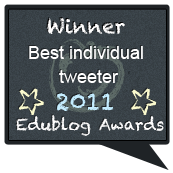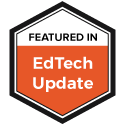
We have a problem in realm of edtech. I am guilty of it and chances are you have been too at some point. You and I are not guilty of it all the time and truthfully, it may have only happened once or twice but it is a constant problem and it is time we deal with it.
There are so many cool tools out there. This blog looks at just a handful available. My Twitter stream provides more, but still, it is just the tip of the iceberg when we are talking about the tools available to teachers. However, much too often do I witness ill-planned professional development centered around tools, when really, they should be centered around student learning.
Last night on #edchat the discussion was about Tech Tools and Student Learning Goals. Specifically, how do we ensure specific technology tools match student learning goals? What needs to be in place for this to happen successfully?
Full Disclosure-Normally I am a moderator and active participant in the weekly #edchat. However over the next 4 months I will be taking a Leadership class that meets on Tuesday nights. So the reflections here are a combination of reading the archive and my personal thoughts, for what thats worth...
Most teachers have experienced a Professional Development session centered around a piece of technology. Some of these sessions we might describe as amazing; they truly had an impact on your teaching and your classroom and really made a difference.
Some of these sessions, however, we might describe as forgettable. Either we were not interested or, moreover, they were not interesting. One of my most forgettable workshops was on Excel. As a science teacher Excel fits in perfect with data capture and analysis. The mathematical functions and graphing features make it perfect for most types of scientific research. I am by no means an Excel expert but I know just enough to keep me out of trouble. In essence I am not an Excel newbie. So I signed up for a class that I thought would show me more power moves I could use with kids and really extend their learning. What I got was how to open a new spreadsheet. What is a cell. What is a row. What is a column. The true basics.
It was obvious this workshop was not going to meet my learning needs so I left. Kids, don't really have that choice. I suppose they could choose to leave but there are other consequences...you know that's a whole other post all together. The point is we have to be mindful of what the needs of our kids are when designing instruction.
So there are two parts to that design when we are talking about incorporating technology. First, those of us who have made a career out of teaching educators how to use technology effectively in the classroom have to do our research. We have to understand curriculum and what exactly our teachers are teaching. We have to present our ideas and tools in the form of learning goals. Meaning, we have to present them in such a way that they always relate back to what we want our students to ultimately learn. Very rarely do we want our students to learn how to just use a particular tool. So we should not present them to our teachers that way.
Second, those of us who have made a career out of educating kids need to make sure we are designing our lessons with a goal in mind. I am not talking about silly state or national standards, because in the long run, in my opinion, they are useless (but that is for another conversation.) I mean, you need to understand what your kids don't and design effective lessons to meet their needs. That lesson may or may not involve tech. If it does, great. Then spend the time on the learning objective, not the tool. Remember, a pencil is a tool and we don't spend a great deal of time teaching how to use it. But we use the tool to accomplish some learning. (Hopefully)
Bottom line. When dealing with tech, learning how to use the tool is important. But we need to make sure we are learning and using the tools in the context of real goals. It does no good to conduct/sit in workshop after workshop learning how to use tools with no, clear learning goals in mind. The conversations must start with the end in mind. Where do we want to be when this is all over? Only after we decide that can we even begin to discuss how we will get there.
 Over the weekend was the annual Educon event in Philadelphia. Held at the Science Leadership Academy, the event aims to bring together all those with a vested interest in education for conversations and discussions about the future of schools.
Over the weekend was the annual Educon event in Philadelphia. Held at the Science Leadership Academy, the event aims to bring together all those with a vested interest in education for conversations and discussions about the future of schools. 
















